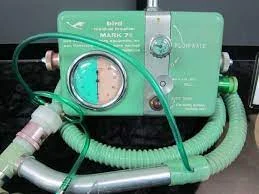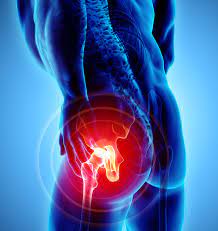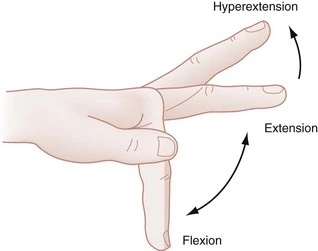Intermittent positive pressure breathing (IPPB)
- Intermittent positive pressure breathing (IPPB) is a technique used to supply short-term or intermittent mechanical ventilation via a mouthpiece or mask for the purpose of augmenting lung expansion and delivering aerosol medication.
- Intermittent positive pressure breathing (IPPB) is commonly not a therapy of choice in treating lung collapse as there are other techniques that are less expensive, easy to administer, and less tasking; It is commonly implored when other therapies failed or the patient is not cooperating.
- Intermittent positive pressure breathing (IPPB) is inspirational using a non-invasive ventilator like the Bird with a pressure boost. The patient stimulates inspiration, with positive pressure support, followed by airway pressure returning to atmospheric pressure with passive expiration.
- The Bird Mark 7 ventilator is a pressure-cycled device convenient to use for providing Intermittent positive pressure breathing (IPPB) as an adjunct to physiotherapy in the spontaneously breathing patient. Intermittent positive pressure breathing (IPPB) may be applied to intubated as well as non-intubated patients.
Table of Contents
Benefits of Intermittent positive pressure breathing (IPPB)
Intermittent positive pressure breathing (IPPB) has been shown to
- Increase the volume of inspiration
- Support weak inspiratory muscles. In a completely relaxed subject, the work of breathing during inspiration is reduced immensely with Intermittent positive pressure breathing (IPPB).
- Help in clearing sputum from the lungs. The 2 prior benefits aid in bronchial secretions clearance when more simple airway clearance techniques alone are not maximally effective.
- Ease the inspiration of large volumes of air
- Assist in the delivery of aerosol medication (nebulizers). The reduction in the work of breathing can be used with effect in the acute severe exhausted asthmatic, yet there is no evidence that the effect of bronchodilators delivered by Intermittent positive pressure breathing (IPPB) is greater than from a nebulizer alone.
- Increase the levels of oxygen and carbon dioxide in your blood
Indication for Intermittent positive pressure breathing (IPPB)
- The requirement to improve lung expansion in the presence of atelectasis when other forms of therapy(incentive spirometry, Chest Physiotherapy Technique, Deep Breathing Exercises, positive airway pressure adjuncts) have been unsuccessful.
- The inability of the patient to clear secretions adequately because of pathology that severely limits the ability to ventilate or cough effectively and failure to respond to other modes of treatment.
- The patient who has an acute flare-up of their breathing problem and is too weak to have an effective cough
- The requirement to deliver aerosol medication to the patient
Procedures for Intermittent positive pressure breathing (IBBP) using Bird mark Ventilator
- Explain the procedure to the patient.
- Attach circuit corrugated tubing, expiratory valve line, and nebulizer tubing to the Intermittent positive pressure breathing (IPPB) machine. Pressure test the circuit and machine to ensure proper function; open up nebulizer control, set inspiratory pressure level, and cycle the machine non-mechanically.
- Block the mouthpiece with sanitized gauze or the sterile circuit package. The machine should cycle off when the before-set inspiratory pressure is reached.
- Aseptically prepare medication as prescribed and insert it in the Intermittent positive pressure breathing (IPPB) nebulizer.
Instruct patient to:
a. Purse lips around mouthpiece so air does not leak, retaining the tongue back.
b. Breathe through the mouth only. Mask may be used if the patient is not able to cooperate with the mouthpiece.
c. Inspire steadily and heavily not letting air “puff” cheeks out. Pause shortly at end of inspiration then breathe out.
- After the patient is comfortable with this technique, treatment can begin.
- Set sensitivity to cycle on with the patient’s inspiratory effort.
- Adjust inspiratory pressure to 10 – 15 cmH2O, assessing sufficient volume by chest expansion and auscultation.
- Adjust nebulizer controls to have medication nebulized sufficiently.
- Monitor the patient throughout the duration of treatment.
- When treatment is complete, detach the circuit from the Intermittent positive pressure breathing (IPPB) machine, discard any excess solution from the nebulizer, and place the circuit in a plastic bag at the bedside for use with the next treatment.
- Age-appropriate considerations involve assessing the patient’s ability to cooperate with a mouthpiece. An appropriate fitting mask may be used if required in geriatrics.
Contraindications for Intermittent positive pressure breathing (IPPB)
- Increased intracranial pressure.
- Hiccups
- Hemodynamic instability.
- Recent facial, oral, or skull surgery.
- Tracheoesophageal fistula.
- Recent esophageal surgery.
- Active hemoptysis.
- Nausea.
- Active, untreated tuberculosis or another respiratory communicable disease.
- Radiographic evidence of bleb.
FAQs
Positive pressure ventilation (PPV) can be delivered in two forms: non-invasive positive pressure ventilation (NIPPV), which is delivered through a special face mask with a tight seal (air travels through anatomical airways), or invasive positive pressure ventilation (IPPV), which involves the delivery of positive pressure ventilation.
Nasal intermittent positive pressure ventilation (NIPPV) is a method of augmenting NCPAP by delivering ventilator breaths via nasal prongs. Older children and adults with chronic respiratory failure have been shown to benefit from NIPPV and the technique has been applied to neonates.
Parameters of the ventilator
The pressure of the ventilated air flows in and out of the lungs. The volume of the breath taken into and breathed out of the lungs. The flow rate of the air into the lungs. The inspiratory and expiratory time.
Positive pressure technique. Positive pressure locking techniques maintain positive pressure inside the lumen in order to prevent blood reflux from the vein into the lumen of the VAD, thus preventing fibrin buildup, clots, and thrombotic device occlusions.
Among the potential adverse physiologic effects of positive-pressure ventilation (PPV) is decreased cardiac output, unintended respiratory alkalosis, increased intracranial pressure, gastric distension, and impairment of hepatic and renal function.
Barotrauma — Pulmonary barotrauma is a well-known complication of positive pressure ventilation (PPV). Consequences include pneumothorax, subcutaneous emphysema, pneumomediastinum, and pneumoperitoneum.
Positive-Pressure Ventilation (PPV)
If the infant remains apneic or gasping, or if the heart rate remains <100 per minute after administering the initial steps, start Positive-Pressure Ventilation (PPV).







